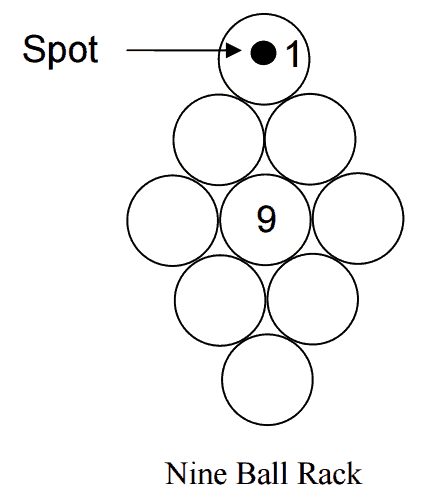2. NINE BALL
Nine ball is played with nine object balls numbered one through nine and the cue ball. The balls are played in ascending numerical order. The player legally pocketing the nine ball wins the rack.
2.1 DETERMINING THE BREAK
The player who wins the lag chooses who will break the first rack. (See 1.2 Lagging to Determine Order of Play.) The standard format is to alternate the break, but see Regulation 16, Subsequent Break Shots.
2.2 NINE BALL RACK
The object balls are racked as tightly as possible in a diamond shape, with the one ball at the apex of the diamond and on the foot spot and the nine ball in the middle of the diamond. The other balls will be placed in the diamond without purposeful or intentional pattern.

2.3 LEGAL BREAK SHOT
The following rules apply to the break shot:
(a) the cue ball begins in hand behind the head string;
(b) if no ball is pocketed, at least four object balls must be driven to one or more rails, or the shot is a foul
(c) additionally, and only when Three Point Break Rule is used, if no ball is pocketed, three balls must cross the head string, or the break is considered ‘dry break’. (See Regulation 18, Three Point Break Rule.)
2.4 SECOND SHOT OF THE RACK – PUSH OUT
If no foul is committed on the break shot, the shooter may choose to play a “push out” as his shot. He must make his intention known to the referee, and then rules 6.2 Wrong Ball First and 6.3 No Rail after Contact are suspended for the shot. If no foul is committed on a push out, the other player chooses who will shoot next.
2.5 CONTINUING PLAY
If the shooter legally pockets any ball on a shot (except a push out, see 2.4 Second Shot of the Rack – Push Out), he continues at the table for the next shot. If he legally pockets the nine ball on any shot (except a push out), he wins the rack. If the shooter fails to pocket a ball or fouls, play passes to the other player, and if no foul was committed, the incoming player must play the cue ball from the position left by the other player.
2.6 SPOTTING BALLS
If the nine ball is pocketed on a foul or push out, or driven off the table, it is spotted. (See 1.4 Spotting Balls.) No other object ball is ever spotted.
2.7 STANDARD FOULS
If the shooter commits a standard foul, play passes to his opponent. The cue ball is in hand, and the incoming player may place it anywhere on the playing surface. (See 1.5 Cue Ball in Hand) The following are standard fouls at nine ball:
6.1 Cue Ball Scratch or off the Table
6.2 Wrong Ball First The first object ball contacted by the cue ball on each shot must be the lowest-numbered ball remaining on the table.
6.3 No Rail after Contact
6.4 No Foot on Floor
6.5 Ball Driven off the Table The only jumped object ball that is spotted is the nine.
6.6 Touched Ball
6.7 Double Hit / Frozen Balls
6.8 Push Shot
6.9 Balls Still Moving
6.10 Bad Cue Ball Placement
6.11 Bad Play from Behind the Head String
6.12 Cue Stick on the Table
6.13 Playing out of Turn
6.14 Three Consecutive Fouls
6.15 Slow Play
6.16 Ball Rack Template Foul
2.8 SERIOUS FOULS
For 6.14 Three Consecutive Fouls, the penalty is loss of the current rack. For 6.17 Unsportsmanlike Conduct, the referee will choose a penalty appropriate given the nature of the offense.
2.9 STALEMATE
If a stalemate occurs the original breaker of the rack will break again. (See 1.12 Stalemate.)
DISCLAIMER: This file contains property copyrighted by the Billiard Congress of America. Any modification or sale of the information herein is strictly prohibited by the laws governing that copyright. However permission is given to distribute this information as public domain granted this disclaimer remains attached. Please direct questions regarding interpretation of the following, or information on how to receive the current BCA “Billiards – The Official Rules and Records book” to the Billiard Congress of America website: www.bca-pool.com